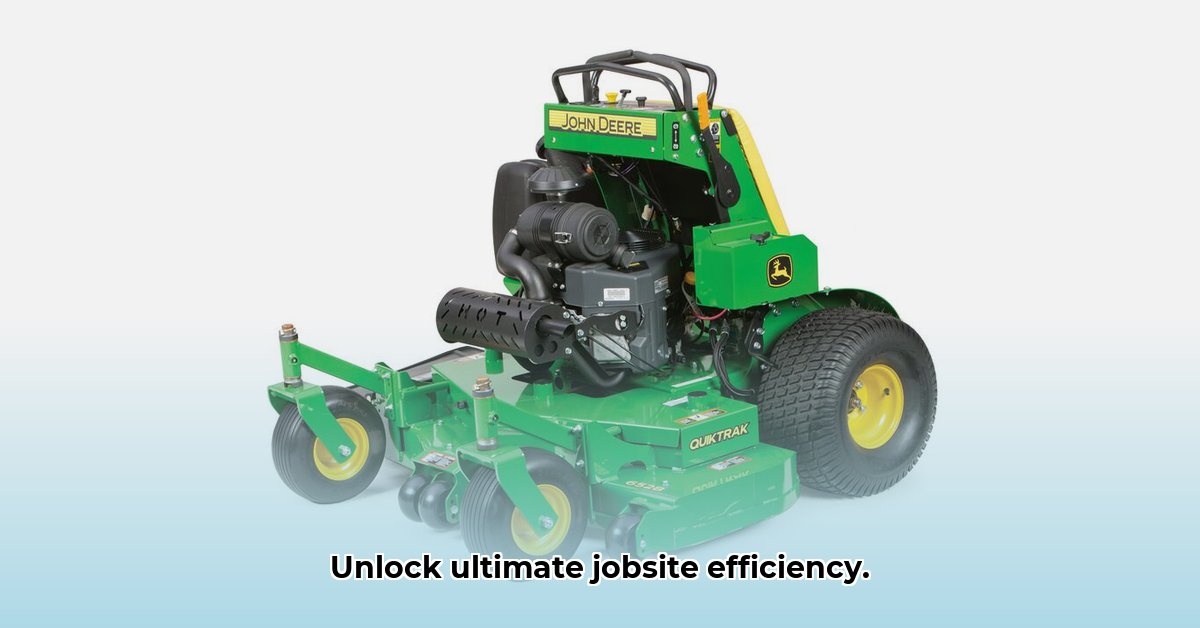
The Rise of Compact Construction Equipment: A Market Overview
The compact construction equipment market, encompassing mini track loaders and stand-on skid steers (often referred to as "stand-up tractors"), is experiencing significant growth. This surge in popularity is driven by several key factors: increased versatility, enhanced efficiency in confined spaces, and reduced labor costs. These machines, with their interchangeable attachments, handle diverse tasks from material handling to ground leveling, significantly boosting jobsite productivity. However, challenges exist, including a lack of technological standardization across manufacturers, concerns regarding operator comfort, and ongoing safety considerations requiring attention. For rentals, check out this equipment rental resource.
Understanding Stand-Up Tractors: Mini Powerhouses for Big Jobs
Stand-up tractors, encompassing mini track loaders and stand-on skid steers, are compact machines designed for optimal operator control and ease of use. Mini track loaders provide superior stability and traction, even on uneven terrain, while stand-on skid steers excel in tight spaces due to their exceptional maneuverability. Both offer a wide array of interchangeable attachments, significantly expanding their applications. Is it any wonder that their versatility is driving market growth?
Maximizing Your Investment: Actionable Strategies for Different Stakeholders
This section provides practical guidance for maximizing the return on investment (ROI) associated with stand-up tractors, offering actionable insights tailored to specific stakeholder groups.
For Equipment Manufacturers: Innovating for the Future
Manufacturers can further enhance the market position of stand-up tractors through strategic investments and design improvements:
- Expand Attachment Options: Develop specialized attachments to broaden the range of applications and appeal to a wider customer base. Consider niche tasks currently underserved by existing equipment.
- Prioritize User-Friendly Designs: Intuitive controls and easy-to-understand interfaces are crucial for boosting operator productivity. Conduct user testing to improve ergonomics and control layout.
- Integrate Advanced Telematics: Implement real-time monitoring, diagnostics, and predictive maintenance features for proactive maintenance and reduced downtime. This significantly improves ROI.
For Contractors/Landscapers: Optimizing Jobsite Performance
Contractors and landscapers can optimize the use of stand-up tractors through these key actions:
- Strategic Equipment Selection: Carefully evaluate project needs, terrain conditions, and budget constraints to select the most suitable machine. Consider rental options for short-term projects.
- Invest in Operator Training: Thorough operator training is essential for maximizing efficiency, minimizing downtime, and ensuring safety. Investing in professional training programs yields significant returns.
- Explore Financing Options: Research various financing strategies, including leasing and equipment loans, to find the most cost-effective solution. Consider tax implications and long-term cost projections.
For Regulatory Bodies: Enhancing Safety and Standardization
Regulatory bodies play a critical role in ensuring the safe and efficient operation of stand-up tractors:
- Update Safety Standards: Regularly review and update safety standards to reflect technological advancements and address emerging risks. Collaborate with manufacturers and industry experts to ensure standards remain current.
- Implement Standardized Testing: Establish standardized testing procedures for performance and safety to ensure fair competition and promote innovation within the industry.
- Enforce Regulations Consistently: Consistent monitoring and enforcement are crucial for ensuring that equipment meets safety standards throughout its operational lifespan. Develop effective mechanisms for reporting and investigating incidents.
Mitigating Equipment Risks: A Proactive Approach
Equipment failures can lead to significant downtime and financial losses. Proactive risk management is key:
| Technology/Feature | Likelihood of Failure | Impact of Failure | Mitigation Strategy |
|---|---|---|---|
| Hydraulic System | Moderate | High | Regular maintenance, redundant systems, safety interlocks, selecting high-quality components |
| Attachment Compatibility | Low | Moderate | Thorough pre-purchase testing and adherence to strict compatibility standards |
| Operator Interface | Low | Moderate | User-friendly design, comprehensive operator training, clear and concise instructions |
| Autonomous Features (Future) | High (Currently) | High | Extensive testing, phased rollouts, robust safety protocols, redundant systems for critical functions |
This matrix highlights potential failures, their impact, and effective mitigation strategies. Regular maintenance, robust design principles, and operator training are crucial for minimizing risks. Note that regional regulations may vary, necessitating further research for specific jurisdictions.
Key Considerations for Choosing Between Mini Track Loaders and Skid Steers
Mini track loaders and skid steers, while both categorized as stand-up tractors, offer distinct advantages. Mini track loaders excel in traction and stability on uneven terrain, while skid steers provide superior maneuverability in tight spaces. Choosing between them requires careful consideration of factors like project size, terrain, budget, and operator experience. A thorough needs assessment is crucial for maximizing efficiency and minimizing risk.
Three Pivotal Points:
- Versatility and efficiency in tight spaces are key drivers of the stand-up tractor market's growth.
- Appropriate operator training and regular maintenance are critical for maximizing ROI and minimizing risks.
- Standardization and updated safety regulations are necessary for the continued growth and safe adoption of the technology.